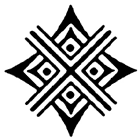 Clicking
on an image will open another window. You can use the second window
to scroll through all the enlarged images associated with this article
Clicking
on an image will open another window. You can use the second window
to scroll through all the enlarged images associated with this article |
The Henna Page Journal |
|
Childbirth and Postpartum Rituals in Early 20th Century Amazigh Morocco Women arriving in the west as refugees from North African famines and wars often have insufficient English to express their concerns to medical personnel, leading to misunderstandings about their need for performance of ritual actions surrounding childbirth. Westermarck (1926) and Legey (1926) recorded meticulous descriptions of the henna traditions and other ritual performances surrounding childbirth in Morocco in the early part of the 20th century. These are comparable to traditions practiced throughout North Africa prior to modernization in those countries. Contemporary urbanized North African women now often regard these traditions as “country”, but they are still practiced in rural areas, and may be reconstructed by women who have nostalgic feelings for their traditions, or who feel comforted by the old rituals. Women routinely arrive in North African maternity clinics with hennaed hands and feet. If they have immigrated to western countries, physicians unfamiliar with the tradition may mistake their henna patterns for skin disease, creating a stressful misunderstanding between doctor and patient. Physicians are often unaware that hennaeing fingernails and toenails does not alter pulse oxymetry readings (Al-Majed, Harakati, 1994) as does fingernail polish, and may insist that the woman try to remove the henna. In most of the tribal groups, women were hennaed, and ornamented with kohl (a traditional black makeup made of antimony) and swak, (a traditional dark lip stain made of walnut root) as if they were brides before they go into labor. These not only deterred malicious spirits, but also prepared the woman for the possibility of dying in childbirth. If a woman died in childbirth, she was believed to enter paradise as a bride, and should be appropriately adorned (Westermarck II, 1926, 383). A woman who died in childbirth was believed to have no punishment after death (Legey, 1926: 119). Women in western maternity clinics are well supported medically to prevent death in childbirth, but no attention is given to her potential entrance into afterlife.
|
|
|
|||
| [Home] [How] [Why] [What] [Where] [FAQ] [Forum] | |||


